- From Issue: Summer 2021 / Vol. 22 No. 2
- by Donovan Quintero
In March 2020, COVID-19 started ravaging the Navajo Nation, turning it into a national hot spot for the virus. The infection rate among Diné (Navajo people) was aggravated by several issues, including chronic underlying illnesses, food and water insecurity, and a lack of electricity among a third of households. Many Diné live in extended families where COVID-19 can spread quickly. There are often vast distances between households and towns, which can make it difficult for Diné to receive public health messages and medical assistance.
Donovan Quintero, a photojournalist for the Navajo Times–Diné bi Naaltsoos, has documented the pandemic’s impact throughout the Navajo Nation and the Diné’s response to it. He began documenting the pandemic when it first struck the reservation. In this photo essay, Quintero explores how the Diné have been impacted by the pandemic and how they have taken care of one another. His photos capture the vast expanse of the reservation and the isolation and resilience of the Diné. His essay also highlights the critical roles played by tribal council members, police, health care workers and the unsung heroes of the pandemic. The essay ends with the COVID-19 vaccine rollout and Diné prayers for the future.

COVID-19 in Indian Country
Native Americans and Alaska Natives throughout the United States have been disproportionately impacted by the COVID-19 pandemic—across all age groups. According to the Centers for Disease Control and Prevention, the rate of lab-confirmed COVID-19 cases among Native Americans and Alaska Natives was 3.5 times higher than among the general population.
Native peoples in the United States have had the highest hospitalization rate of any racial and ethnic group in the country. There are multiple historic reasons for this. Most critically, Native Americans and Alaska Natives have higher rates of underlying chronic diseases than the general U.S. population. This health care crisis is, in no small measure, due to the failure of the United States to live up to its treaty obligations to Native Nations.
The United States signed a series of treaties with Native Nations, making promises in exchange for parts, or the entirety, of their sovereign territories. The U.S. Supreme Court has repeatedly recognized these treaties as legally binding. The unmet treaty rights have contributed to enormous health disparities between Native Americans and the general U.S. population, including a lack of access to well-equipped and staffed medical facilities.
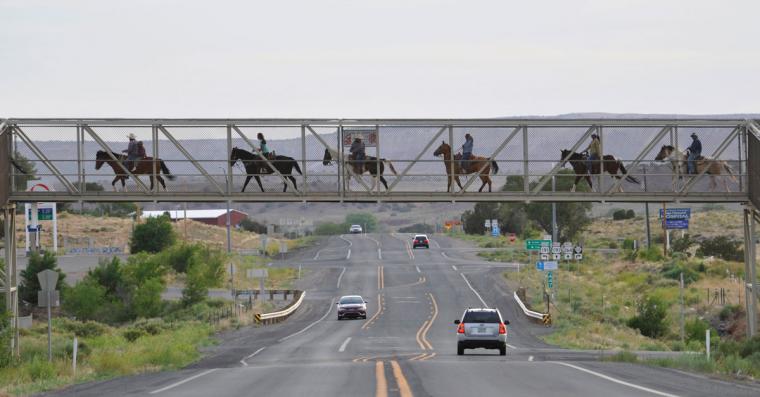
Ganado, Arizona, Navajo Nation, June 28, 2020
A Diné family, out for an excursion, ride their horses over Arizona State Highway 264 to maintain a healthy lifestyle and mental outlook. During the COVID-19 pandemic, Diné families have had to endure more curfews than any other people in the United States. The Navajo Nation instituted a 57-hour weekend lockdown from Friday evening to Monday morning as well as nightly curfews beginning at 8 p.m. or 9 p.m. and ending at 5 a.m.
© Navajo Times, 2020
Diné Family on Horseback
Ganado, Arizona, Navajo Nation, June 28, 2020
A Diné family, out for an excursion, ride their horses over Arizona State Highway 264 to maintain a healthy lifestyle and mental outlook. During the COVID-19 pandemic, Diné families have had to endure more curfews than any other people in the United States. The Navajo Nation instituted a 57-hour weekend lockdown from Friday evening to Monday morning as well as nightly curfews beginning at 8 p.m. or 9 p.m. and ending at 5 a.m.
© Navajo Times, 2020
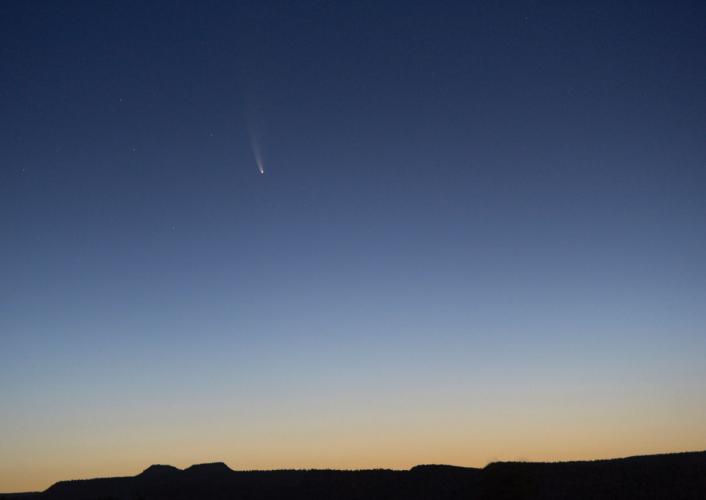
Chuska Mountains, Navajo Nation, July 10, 2020
A comet soars through the early morning sky in the Navajo Nation. The Diné (Navajo people) consider comets, eclipses, meteor showers and other celestial events to be omens. Since the arrival of the Spanish in the late 1500s, the Diné have suffered and endured many diseases and conditions, including the mumps, parotitis, rheumatic fever, pneumonia, measles, bronchitis, typhoid, malaria, chronic diarrhea, constipation, syphilis, influenza and hantavirus. In 2020, the Diné were struck by a new deadly and unseen sickness they call “ch’osh doo yit’iinii” or “ha’t’ííshíí na’ałniihi,” commonly known as COVID-19.
In April 2020, photographer Donovan Quintero spoke to Diné star gazers, known as “hataałii adéíst’į´į́’ ííł’ínígíí,” about the virus. They said it was born from the ashes of mammals and reptiles that burned in the Australian fires in 2019. According to the hataałii adéíst’į´į́’ ííł’ínígíí, the ashes of the animals rose into the air, which weakened the ozone enough for cosmic rays to shoot an entity into the ocean. This caused the earth to open up and release an energy that impacted fish and other marine life before reaching the surface. Humans and other animals ate the fish. Soon the entity formed into a virus that first affected the mammal and reptile kingdoms before transforming to infect humans. The first person to be infected by the virus became sick and soon died. The virus then took on a new form. It became a ghost, said the hataałii adéíst’į´į́’ ííł’ínígíí. The ghost-virus then began its journey infecting the world. It hid in the darkness, making it hard to see. The hataałii adéíst’į´į́’ ííł’ínígíí said a number of ceremonies need to be performed in order to restore balance.
© Donovan Quintero, 2020
An Omen in the Sky
Chuska Mountains, Navajo Nation, July 10, 2020
A comet soars through the early morning sky in the Navajo Nation. The Diné (Navajo people) consider comets, eclipses, meteor showers and other celestial events to be omens. Since the arrival of the Spanish in the late 1500s, the Diné have suffered and endured many diseases and conditions, including the mumps, parotitis, rheumatic fever, pneumonia, measles, bronchitis, typhoid, malaria, chronic diarrhea, constipation, syphilis, influenza and hantavirus. In 2020, the Diné were struck by a new deadly and unseen sickness they call “ch’osh doo yit’iinii” or “ha’t’ííshíí na’ałniihi,” commonly known as COVID-19.
In April 2020, photographer Donovan Quintero spoke to Diné star gazers, known as “hataałii adéíst’į´į́’ ííł’ínígíí,” about the virus. They said it was born from the ashes of mammals and reptiles that burned in the Australian fires in 2019. According to the hataałii adéíst’į´į́’ ííł’ínígíí, the ashes of the animals rose into the air, which weakened the ozone enough for cosmic rays to shoot an entity into the ocean. This caused the earth to open up and release an energy that impacted fish and other marine life before reaching the surface. Humans and other animals ate the fish. Soon the entity formed into a virus that first affected the mammal and reptile kingdoms before transforming to infect humans. The first person to be infected by the virus became sick and soon died. The virus then took on a new form. It became a ghost, said the hataałii adéíst’į´į́’ ííł’ínígíí. The ghost-virus then began its journey infecting the world. It hid in the darkness, making it hard to see. The hataałii adéíst’į´į́’ ííł’ínígíí said a number of ceremonies need to be performed in order to restore balance.
© Donovan Quintero, 2020
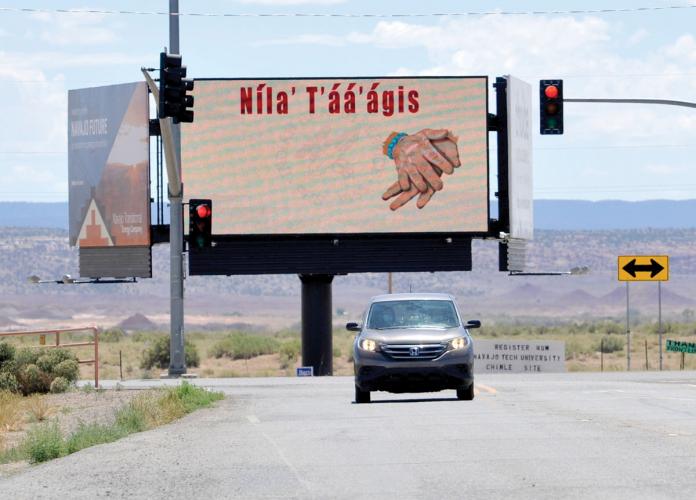
Chinle, Arizona, Navajo Nation, July 10, 2020
The Navajo Nation encompasses 27,000 square miles and extends into parts of Arizona, New Mexico and Utah. Many Diné must drive for hours to get to schools, grocery stores, post offices, gas stations and medical services. Since the COVID-19 pandemic arrived in March 2020, the Navajo Nation Department of Health has issued public health orders to stop the spread of the virus. This billboard, in Navajo, instructs people to wash their hands. Other orders instruct Diné to wear masks, socially distance and stay home unless conducting essential business. In the Navajo Nation, essential business may include getting food, hauling water and firewood, feeding livestock or driving to the hospital in an emergency.
© Donovan Quintero, 2020
Public Health Message
Chinle, Arizona, Navajo Nation, July 10, 2020
The Navajo Nation encompasses 27,000 square miles and extends into parts of Arizona, New Mexico and Utah. Many Diné must drive for hours to get to schools, grocery stores, post offices, gas stations and medical services. Since the COVID-19 pandemic arrived in March 2020, the Navajo Nation Department of Health has issued public health orders to stop the spread of the virus. This billboard, in Navajo, instructs people to wash their hands. Other orders instruct Diné to wear masks, socially distance and stay home unless conducting essential business. In the Navajo Nation, essential business may include getting food, hauling water and firewood, feeding livestock or driving to the hospital in an emergency.
© Donovan Quintero, 2020
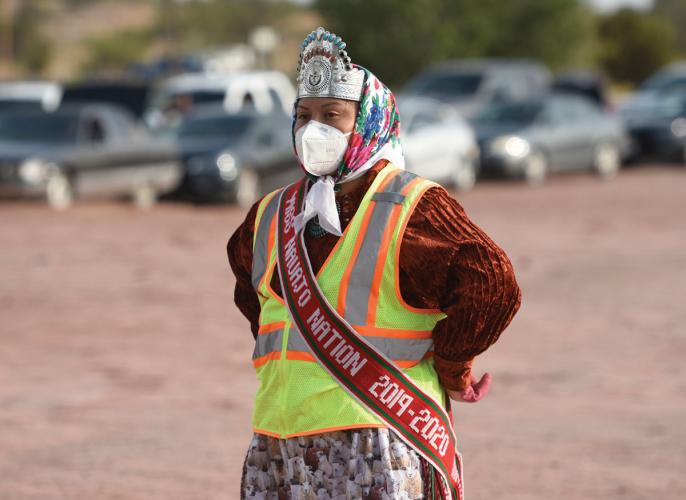
Ganado, Arizona, Navajo Nation, October 2, 2020
Shaandiin Parrish, Miss Navajo Nation, takes a brief pause while distributing food to Ganado community members. A political science graduate from Arizona State University, Parrish was selected as Miss Navajo Nation in September 2019. Since the COVID-19 pandemic began, she has been traveling across the Navajo Nation distributing food to Diné families. Parrish was selected because of her embodiment of the Navajo values imparted to her during her “Kinaaldá,” or coming-of-age ceremony, as well as for her academic accomplishments. She may continue holding the Miss Navajo Nation title into 2022 if the annual contest continues to be postponed because of the pandemic.
© Navajo Times, 2020
Miss Navajo Nation Distributing Food
Ganado, Arizona, Navajo Nation, October 2, 2020
Shaandiin Parrish, Miss Navajo Nation, takes a brief pause while distributing food to Ganado community members. A political science graduate from Arizona State University, Parrish was selected as Miss Navajo Nation in September 2019. Since the COVID-19 pandemic began, she has been traveling across the Navajo Nation distributing food to Diné families. Parrish was selected because of her embodiment of the Navajo values imparted to her during her “Kinaaldá,” or coming-of-age ceremony, as well as for her academic accomplishments. She may continue holding the Miss Navajo Nation title into 2022 if the annual contest continues to be postponed because of the pandemic.
© Navajo Times, 2020
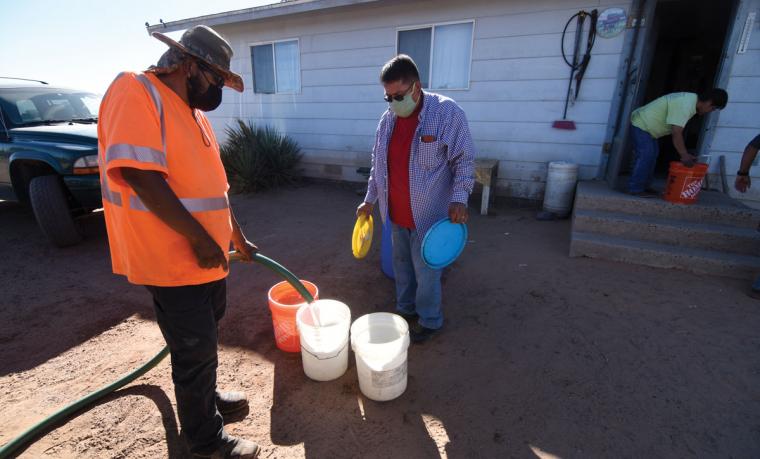
Jeddito, Arizona, Navajo Nation, October 14, 2020
Navajo Nation Council Delegate Vince James holds bucket lids as a volunteer fills buckets with drinking water. James, who represents the Jeddito community, has been delivering water to his elderly constituents since the start of the COVID-19 pandemic. He has been assisted by Zoel Zohnnie, founder of Collective Medicine, a Native American network whose purpose is to gather resources that benefit and comfort Native people. Without running water, the frequent washing of hands—prescribed by the CDC—is difficult at best.
© Navajo Times, 2020
Delivering Drinking Water
Jeddito, Arizona, Navajo Nation, October 14, 2020
Navajo Nation Council Delegate Vince James holds bucket lids as a volunteer fills buckets with drinking water. James, who represents the Jeddito community, has been delivering water to his elderly constituents since the start of the COVID-19 pandemic. He has been assisted by Zoel Zohnnie, founder of Collective Medicine, a Native American network whose purpose is to gather resources that benefit and comfort Native people. Without running water, the frequent washing of hands—prescribed by the CDC—is difficult at best.
© Navajo Times, 2020
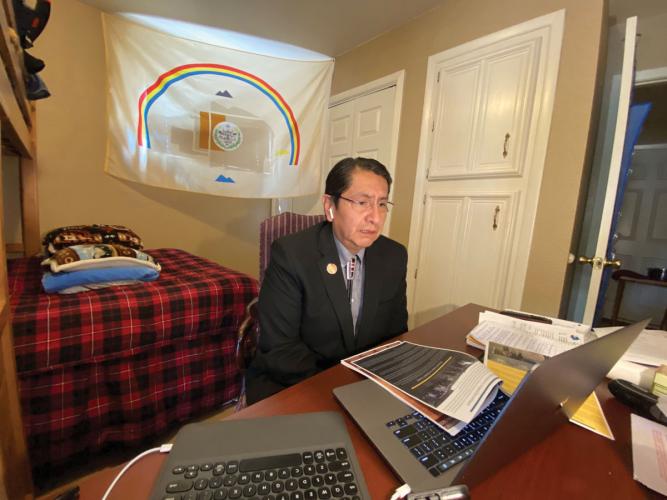
Window Rock, Arizona, Navajo Nation, April 20, 2020
Navajo Nation President Jonathan Nez gives his State of the Nation Address from his son’s bedroom on the last day of a 14-day quarantine. Both President Nez and Navajo Nation Vice President Myron Lizer were exposed to COVID-19 during a visit to Tuba City, Arizona. President Nez reported then that there had been 1,104 confirmed COVID-19 cases and 45 deaths in the Navajo Nation since the outbreak began. (As of mid-June 2021, nearly 31,000 cases have been confirmed and more than 1,300 people in the Navajo Nation have died.) Nez also reported on the efforts of the Navajo Nation COVID-19 Preparedness Team and the Navajo Nation Council to minimize the spread of the virus.
© Navajo Times, 2020
Addressing the Navajo Nation
Window Rock, Arizona, Navajo Nation, April 20, 2020
Navajo Nation President Jonathan Nez gives his State of the Nation Address from his son’s bedroom on the last day of a 14-day quarantine. Both President Nez and Navajo Nation Vice President Myron Lizer were exposed to COVID-19 during a visit to Tuba City, Arizona. President Nez reported then that there had been 1,104 confirmed COVID-19 cases and 45 deaths in the Navajo Nation since the outbreak began. (As of mid-June 2021, nearly 31,000 cases have been confirmed and more than 1,300 people in the Navajo Nation have died.) Nez also reported on the efforts of the Navajo Nation COVID-19 Preparedness Team and the Navajo Nation Council to minimize the spread of the virus.
© Navajo Times, 2020
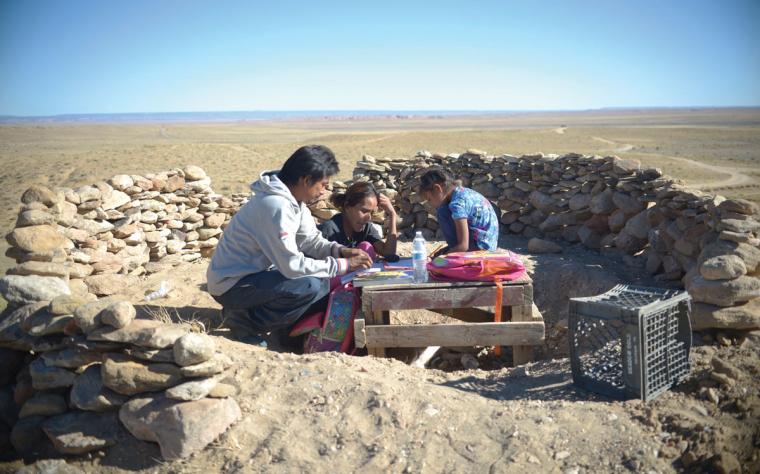
Fish Point, Arizona, Navajo Nation, October 19, 2020
Milton T. Carroll and Wylean Burbank help their daughter Kyla with her schoolwork in a makeshift outdoor classroom. Kyla is a first-grader at Cottonwood Day School, a Bureau of Indian Education school. Carroll constructed the makeshift classroom on top of a hill near their home so that, hopefully, the family could receive cell phone reception and Wi-Fi service. Having neither in their home, their daughter was unable to do her homework. Carroll later modified the classroom by expanding the walls and adding a woodstove for warmth. As of February 2021, the Navajo Tribal Utility Authority was trying to install Wi-Fi service in their home.
© Navajo Times, 2020
Makeshift Classroom
Fish Point, Arizona, Navajo Nation, October 19, 2020
Milton T. Carroll and Wylean Burbank help their daughter Kyla with her schoolwork in a makeshift outdoor classroom. Kyla is a first-grader at Cottonwood Day School, a Bureau of Indian Education school. Carroll constructed the makeshift classroom on top of a hill near their home so that, hopefully, the family could receive cell phone reception and Wi-Fi service. Having neither in their home, their daughter was unable to do her homework. Carroll later modified the classroom by expanding the walls and adding a woodstove for warmth. As of February 2021, the Navajo Tribal Utility Authority was trying to install Wi-Fi service in their home.
© Navajo Times, 2020
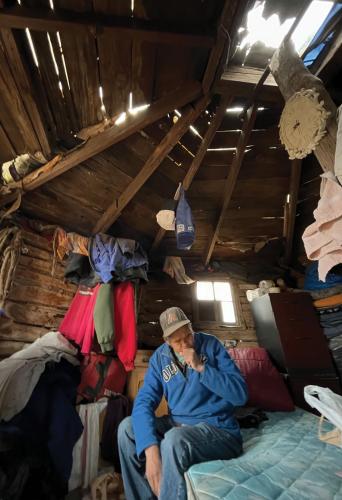
Wide Ruins, Arizona, Navajo Nation, November 27, 2020
Harrison Kee, 60, coughs into his hand while speaking about the holes in the roof of his “hogan,” or traditional Diné home. Kee’s hogan is badly in need of repair. He has placed plastic over the roof to keep the rain and snow out. According to Navajo Nation Police Officer Marwin Joe, Kee takes his ax and wheelbarrow into the nearby woods to chop and collect wood, which he burns to cook and stay warm. Despite volunteers bringing Kee wood, food and water, his hogan still threatens to cave in.
© Navajo Times, 2020
Diné Elder at Home
Wide Ruins, Arizona, Navajo Nation, November 27, 2020
Harrison Kee, 60, coughs into his hand while speaking about the holes in the roof of his “hogan,” or traditional Diné home. Kee’s hogan is badly in need of repair. He has placed plastic over the roof to keep the rain and snow out. According to Navajo Nation Police Officer Marwin Joe, Kee takes his ax and wheelbarrow into the nearby woods to chop and collect wood, which he burns to cook and stay warm. Despite volunteers bringing Kee wood, food and water, his hogan still threatens to cave in.
© Navajo Times, 2020
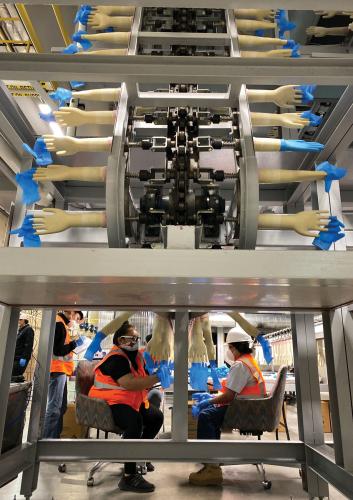
Church Rock, New Mexico, Navajo Nation, March 25, 2020
Rhino Health employee Nizhoni Long (left) and her coworkers produce medical-grade nitrile gloves. Since the COVID-19 pandemic started, the company has been making 8,000 gloves an hour. The pandemic caused a nationwide shortage of personal protective equipment (PPE). This forced health care workers and first responders, including police officers and emergency medical technicians, to reuse their PPE while combatting the virus. Rhino Health was regularly backlogged three to four weeks as it supplied the Navajo Nation, New York, New Mexico, New Jersey and Wisconsin with gloves.
© Navajo Times, 2020
Making Nitrile Gloves
Church Rock, New Mexico, Navajo Nation, March 25, 2020
Rhino Health employee Nizhoni Long (left) and her coworkers produce medical-grade nitrile gloves. Since the COVID-19 pandemic started, the company has been making 8,000 gloves an hour. The pandemic caused a nationwide shortage of personal protective equipment (PPE). This forced health care workers and first responders, including police officers and emergency medical technicians, to reuse their PPE while combatting the virus. Rhino Health was regularly backlogged three to four weeks as it supplied the Navajo Nation, New York, New Mexico, New Jersey and Wisconsin with gloves.
© Navajo Times, 2020
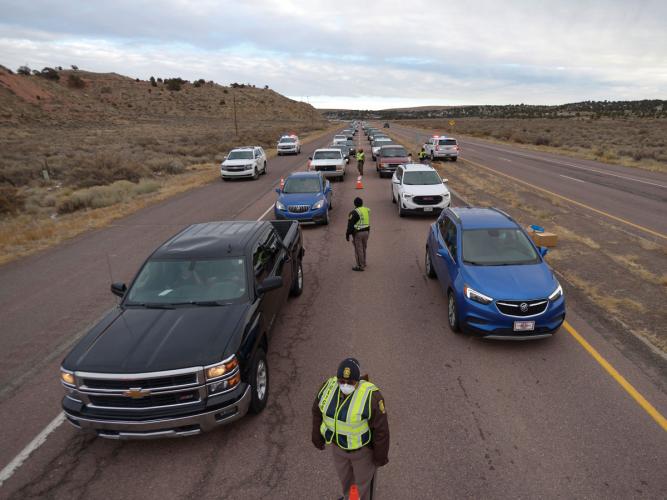
Tse Bonito, New Mexico, Navajo Nation, December 31, 2020
Navajo Nation police officers stop cars at a checkpoint on New Mexico State Highway 264 on New Year’s Eve. The Navajo Nation Police Department is highly respected on the reservation. Since March 2020, they have enforced nightly and weekend curfews, the mandatory wearing of face masks in public and closure of nonessential businesses.
© Navajo Times, 2020
Traffic Checkpoint
Tse Bonito, New Mexico, Navajo Nation, December 31, 2020
Navajo Nation police officers stop cars at a checkpoint on New Mexico State Highway 264 on New Year’s Eve. The Navajo Nation Police Department is highly respected on the reservation. Since March 2020, they have enforced nightly and weekend curfews, the mandatory wearing of face masks in public and closure of nonessential businesses.
© Navajo Times, 2020
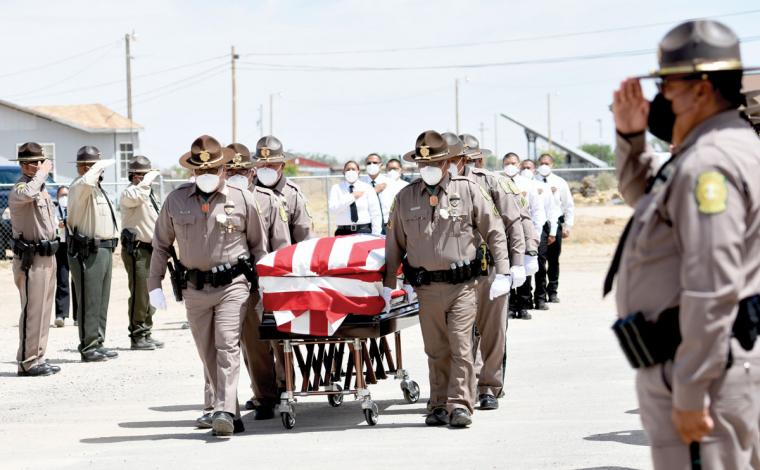
Chinle, Arizona, Navajo Nation, June 25, 2020
Fellow officers salute fallen Navajo Nation Police Officer Michael Lee, whose casket is escorted by the Navajo Nation Police Honor Guard. Officer Lee graduated from the Navajo Law Enforcement Academy in Toyei, Arizona, in 1990, and served in the Navajo Nation Police Department for 29 years. A husband and father, he was the first Arizona police officer to die in the line of duty from COVID-19.
© Navajo Times, 2020
Navajo Nation Police Honor Guard
Chinle, Arizona, Navajo Nation, June 25, 2020
Fellow officers salute fallen Navajo Nation Police Officer Michael Lee, whose casket is escorted by the Navajo Nation Police Honor Guard. Officer Lee graduated from the Navajo Law Enforcement Academy in Toyei, Arizona, in 1990, and served in the Navajo Nation Police Department for 29 years. A husband and father, he was the first Arizona police officer to die in the line of duty from COVID-19.
© Navajo Times, 2020
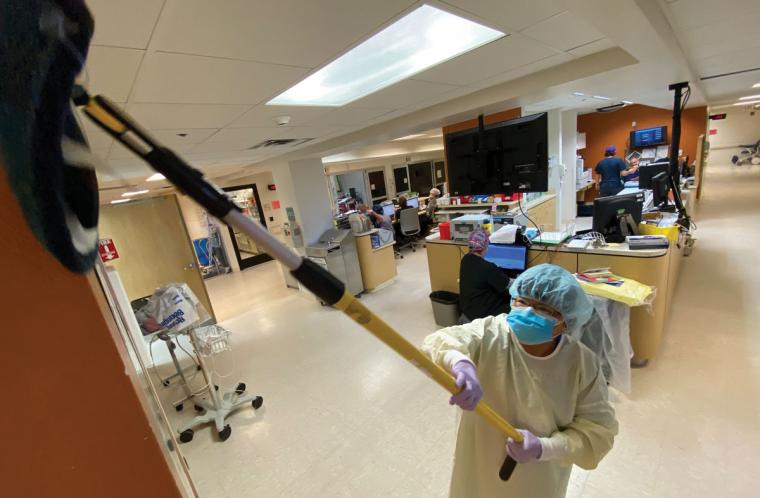
Gallup, New Mexico, June 29, 2020
Cleaning and disinfecting surfaces have taken on a new urgency, even for those unsung heroes in the medical profession, for whom it is a daily routine. Rehoboth McKinley Christian Health Care Services housekeeper Edith Sherman sanitizes the hospital’s emergency room. For the past two years, Sherman has made sure the emergency department—especially the patients’ rooms—were cleaned, sometimes up to eight times a day. “People trust us that come out here to the hospital,” she said. “They trust us with their lives.”
© Navajo Times, 2020
Cleaning and Disinfecting
Gallup, New Mexico, June 29, 2020
Cleaning and disinfecting surfaces have taken on a new urgency, even for those unsung heroes in the medical profession, for whom it is a daily routine. Rehoboth McKinley Christian Health Care Services housekeeper Edith Sherman sanitizes the hospital’s emergency room. For the past two years, Sherman has made sure the emergency department—especially the patients’ rooms—were cleaned, sometimes up to eight times a day. “People trust us that come out here to the hospital,” she said. “They trust us with their lives.”
© Navajo Times, 2020
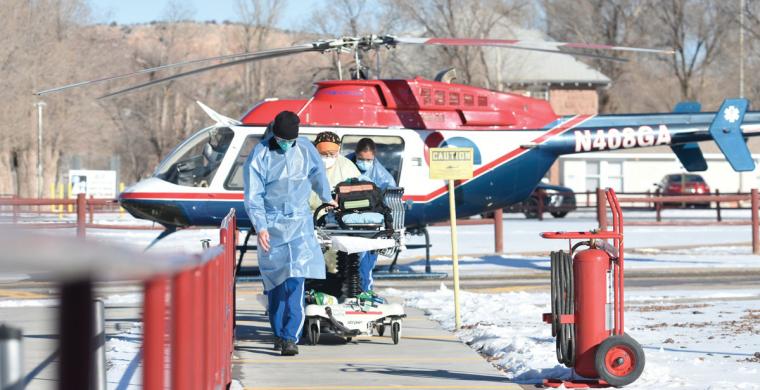
Ganado, Arizona, Navajo Nation, December 15, 2020
Health care workers wheel a gurney into the Sage Memorial Hospital to evacuate a COVID-19 patient by helicopter. There are five Indian Health Service hospitals in the Navajo Nation and seven full-time health centers serving about 160,000 people. Sage Memorial Hospital is the first Native-managed private health care hospital in the country. It serves 23,000 Diné. Critically ill COVID-19 patients are often transported to medical facilities outside the Navajo Nation.
© Donovan Quintero, 2020
Helping COVID-19 Patients
Ganado, Arizona, Navajo Nation, December 15, 2020
Health care workers wheel a gurney into the Sage Memorial Hospital to evacuate a COVID-19 patient by helicopter. There are five Indian Health Service hospitals in the Navajo Nation and seven full-time health centers serving about 160,000 people. Sage Memorial Hospital is the first Native-managed private health care hospital in the country. It serves 23,000 Diné. Critically ill COVID-19 patients are often transported to medical facilities outside the Navajo Nation.
© Donovan Quintero, 2020
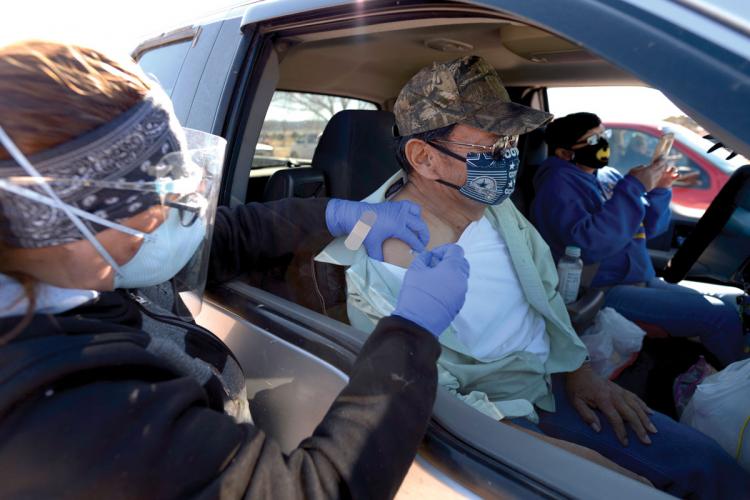
Thoreau, New Mexico, Navajo Nation, January 12, 2021
Edison Sloan, 72, sits quietly as Vicky Charley, a registered nurse at the Crownpoint Service Unit, gives him the first dose of the Pfizer-BioNTech COVID-19 vaccine. He is accompanied by his daughter, Leah Sloan. On the same day, between 120 and 150 other senior citizens also received their first dose of the two-dose vaccine. As of mid-June 2021, nearly 250,000 doses had been administered across the Navajo Nation and nearly 115,000 Diné had been fully immunized.
© Navajo Times, 2021
Getting Vaccinated
Thoreau, New Mexico, Navajo Nation, January 12, 2021
Edison Sloan, 72, sits quietly as Vicky Charley, a registered nurse at the Crownpoint Service Unit, gives him the first dose of the Pfizer-BioNTech COVID-19 vaccine. He is accompanied by his daughter, Leah Sloan. On the same day, between 120 and 150 other senior citizens also received their first dose of the two-dose vaccine. As of mid-June 2021, nearly 250,000 doses had been administered across the Navajo Nation and nearly 115,000 Diné had been fully immunized.
© Navajo Times, 2021
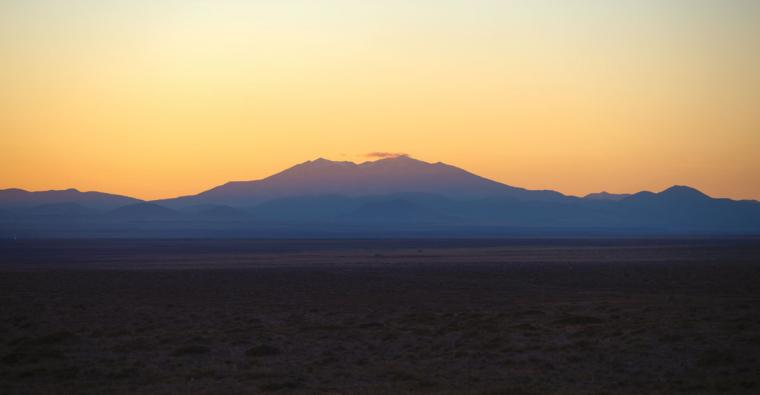
Bird Springs, Arizona, Navajo Nation, January 9, 2021
Driving back from an assignment one day, photographer Donovan Quintero noticed the sunlight painting the snow-capped Dook’o’oosłííd (San Francisco Peaks). He pulled over and captured this photo.
Dook’o’oosłííd, which can be translated as “the top is shining,” is one of six mountains sacred to the Diné. The Diné view the mountains as their protectors. Dook’o’oosłííd is located to the west, Sis Naajiní (Blanca Peak) to the east, Tsoodził (Mount Taylor) to the south and Dibé Nstaa (Hesperus Mountain) to the north of the Navajo Nation. Dził Ná’oodiłii (Huérfano Mountain) and Ch’óol’į´į́’ or Dził Ch’óol’į´’į́’(Gobernador Knob) are at the center of the Navajo Nation. Traditional Diné religious leaders and herbalists have been performing ceremonies at Dook’o’oosłííd to help combat the COVID-19 pandemic and restore balance and harmony to people’s lives.
© Donovan Quintero, 2021
Dook’o’oosłÍÍd (San Francisco Peaks)
Bird Springs, Arizona, Navajo Nation, January 9, 2021
Driving back from an assignment one day, photographer Donovan Quintero noticed the sunlight painting the snow-capped Dook’o’oosłííd (San Francisco Peaks). He pulled over and captured this photo.
Dook’o’oosłííd, which can be translated as “the top is shining,” is one of six mountains sacred to the Diné. The Diné view the mountains as their protectors. Dook’o’oosłííd is located to the west, Sis Naajiní (Blanca Peak) to the east, Tsoodził (Mount Taylor) to the south and Dibé Nstaa (Hesperus Mountain) to the north of the Navajo Nation. Dził Ná’oodiłii (Huérfano Mountain) and Ch’óol’į´į́’ or Dził Ch’óol’į´’į́’(Gobernador Knob) are at the center of the Navajo Nation. Traditional Diné religious leaders and herbalists have been performing ceremonies at Dook’o’oosłííd to help combat the COVID-19 pandemic and restore balance and harmony to people’s lives.
© Donovan Quintero, 2021
View the full virtual exhibition and listen to an interview with the photographers of this and other “Developing Stories: Native Photographers in the Field” photo essays at AmericanIndian.si.edu/developingstories.
Authors
Award-winning photojournalist Donovan Quintero was born in the Navajo Nation. Since 2005, he has worked for the “Navajo Times–Diné Bi Naaltsoos,” covering news, sports and feature stories.
